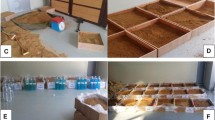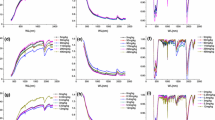Abstract
In this study, we constructed indoor testbed to apply aerial hyper-spectral imaging sensor was to monitoring to heavy metal contaminated in soil. And a ground-based spectro-radiometer data and hyper-spectral image data were obtained for soil samples artificially contaminated with two heavy metals (Cu, Pb). Based on the comparison of spectro-radiometer and actual concentration data, specific wavelength band was classified by linear regression analysis and statistical analysis. We have established a preprocessing methodology that represents the most correlated specific wavelengths through logarithmic and derivative transformations on the reflectance data for each concentration gradient of heavy metals. Among the various methods, (Log (1/R))′ conversion was confirmed as the most effective pre-processing method for extracting specific wavelength. Then, the spectral characteristic patterns of the soil contaminated with heavy metals were confirmed through the hyper-spectral image data constructed in the indoor test bed, and spectral angle mapper which is one of the spectral characteristic matching methods was applied to confirm the classification feasibility of soil contaminated with the heavy metals.






Similar content being viewed by others
References
Shepherd, K. D., & Walsh, M. G. (2007). Infrared spectroscopy-enabling an evidence-based diagnostic surveillance approach to agricultural and environmental management in developing countries. Journal of Near Infrared Spectroscopy, 15, 1–19.
Winkelmann, H. (2005). On the applicability of imaging spectrometry for the detection and investigation of contaminated sites with particular consideration given to the detection of fuel hydrocarbon contaminants in soil. Faculty of Environmental Sciences and Process Engineering, Brandenburg University of Technology. PhD thesis.
Wu, Y., Chen, J. J. I., Tian, Q. J., & Wu, X. (2005). Feasibility of reflectance spectroscopy for the assessment of soil mercury contamination. Environmental Science and Technology, 39(3), 873–878.
Scheinost, A. C., & Schwertmann, U. (1999). Color identification of iron oxides and hydroxysulfates: Use and limitations. Soil Science Society of America Journal, 63, 1463–1471.
Ji, J. F., Balsam, W. L., Chen, J., & Liu, L. W. (2002). Rapid and quantitative measurement of hematite and goethite in the Chinese Loess-Paleosol sequence by diffuse reflectance spectroscopy. Clays and Clay Minerals, 50, 210–218.
Mohamed, E. S., Saleh, A. M., Belal, A. B., Gad, A. A. (2017). Application of near-infrared reflectance for quantitative assessment of soil properties. The Egyptian Journal of Remote Sensing and Space Science (In Press, Corrected Proof).
Kemper, T., & Sommer, S. (2002). Estimate of heavy metal contamination in soils after a mining accident using reflectance spectroscopy. Environmental Science and Technology, 36, 2742–2747.
Ren, H.-Y., Zhuang, D.-F., Singh, A. N., Pan, J.-J., Qiu, D.-S., & Shi, R.-H. (2009). Estimation of As and Cu contamination in agricultural soils around a mining area by reflectance spectroscopy: A case study. Pedosphere, 19, 719–726.
Jun, B. D., Torao, K., Fu, J., Horiuchi, Y., Kim, J. H., & Kim, E. N. (2016). Field management system for green tea utilizing on-site remote sensing technique. Spatial Information Research, 24(3), 335–345.
Shin, J. I., Kim, I. J., & Kim, D. W. (2016). Accuracy assessment of supervised classification using training samples acquired by a field spectroradiometer—A case study for Kumnam-myun, Sejong City. Journal of the Korean Society for Geospatial Information Science, 24(1), 121–128.
NIAST. (2000). Methods of soil and plant analysis. Suwon: National Institute of Agricultural Science and Technology, RDA.
Yu, J. H., Shin, J. I., & Kim, D. H. (2013). An indexing and K-NN query algorithm based on pyramid-technique for target detection of hyperspectral image. Journal of KISS, 39(3), 180–192.
Mondal, I., Bandyopadhyay, J., & Dhara, S. (2017). Detecting shoreline changing trends using principle component analysis in Sagar Island, West Bengal, India. Spatial Information Research, 25(1), 67–73.
Tan, P., Steinbach, M., & Kumar, V. (2005). Introduction to data mining. Boston: Addison Wesley.
Viscarra Rossel, R. A., Chappell, A., De Caritat, P., & Mckenzie, N. J. (2011). On the soil information content of visible-near infrared reflectance spectra. European Journal of Soil Science, 62, 442–453.
Acknowledgements
This work has been supported by Geo-Advanced Innovative Action(GAIA) Project (Grants No. 2015000540009) funded by the Ministry of Environment and Korea of Korea through the Soil Environment Center at Korea Environmental Industry & Technology Institute (KEITI).
Author information
Authors and Affiliations
Corresponding author
Rights and permissions
About this article
Cite this article
Kang, S., Lee, KY., Jeon, EI. et al. Evaluating laboratory-based classification potentials of heavy metal contaminated soils using spectro-radiometer and hyper-spectral imagery. Spat. Inf. Res. 26, 213–221 (2018). https://doi.org/10.1007/s41324-018-0172-4
Received:
Revised:
Accepted:
Published:
Issue Date:
DOI: https://doi.org/10.1007/s41324-018-0172-4




